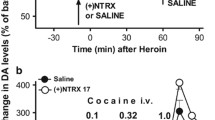Abstract
We previously reported that the reinforcing effects of opioids are enhanced in combination with antihistamines. In the present study, effects of opioids and antihistamines on the reinforcing effects of psychostimulants such as methamphetamine and cocaine were investigated by utilizing the conditioned place preference procedure in rats. The place preference induced by methamphetamine was enhanced in combination with either morphine or chlorpheniramine, which produced additive and potentiative effects, respectively. In contrast, although the preference for cocaine was also enhanced by combination with these two drugs, morphine caused a potentiative effect and chlorpheniramine an additive one. In other words, the reinforcing effect of methamphetamine was differentially enhanced by opioids and antihistamines as compared to that of cocaine. These results suggest that the mechanism of reinforcing effect of methamphetamine is different from that of cocaine, resembling rather those of opioids.
Similar content being viewed by others
References
Balster RT, Schuster CR (1977) A preference procedure that compares of different intravenous drug reinforcers in the rhesus monkey. In: Ellinwood EH Jr, Kilbey MM (eds) Cocaine and other stimulants. Plenum Press, New York, pp. 571–584
Bedford JA, Bailey LP, Wilson MC (1987) Cocaine reinforced progressive ratio performance in the rhesus monkey. Pharmacol Biochem Behav 9:631–638
Brady JV, Griffiths RR (1977) Drug-maintained performance and the analysis of stimulant reinforcing effects. In: Ellinwood EH Jr, Kilbey MM (eds) Cocaine and other stimulants. Plenum Press, New York, pp 599–611
Brown EE, Pinlay JM, Wong JT, Damsma G, Fibiger HC (1991) Behavioral and neurochemical interactions between cocaine and buprenorphine: implications for the pharmacotherapy of cocaine abuse. J Pharmacol Exp Ther 256:119–126
Greene MH, Dupont RL (1973) An outbreak of intravenous amphetamine abuse in heroin addicts. 5th National Conference on Methadone Treatment, pp 776–785
Imperato A, Di Chiara G (1985) Opposite effects of μ and κ opiate agonists on dopamine release in the nucleus accumbens and caudate of freely-moving rats. Br J Pharmacol 86:532
Johanson CE, Schuster CR (1975) A choice procedure for drug reinforcers: cocaine and methylphenydate in the rhesus monkey. J Pharmacol Exp Ther 193:676–688
Langer SZ, Arbilla S (1984) The amphetamine paradox in dopaminergic neurotransmission. TIPS 4:387–390
Langrod J (1970) Secondary drug use among heroin users. Int J Addict 5:611–635
Mucha RF, Herz A (1985) Motivational properties of κ and μ-opioid receptor agonists studied with place and taste preference conditioning procedures. Psychopharmacology 86:274–280
Mucha RF, Iversen SD (1984) Reinforcing properties of morphine and naloxone revealed by conditioned place preference: a procedural examination. Psychopharmacology 82:241–247
Ritz MC, Kuhar MJ (1988) Relationship between self-administration of amphetamine and monoamine receptors in brain: comparison with cocaine. J Pharmacol Exp Ther 248:1010–1017
Roberts DCS, Loh EA, Vickers G (1989) Self-administration of cocaine on a progressive ratio schedule in rats: dose-response relationship and effect of haloperidol pretreatment. Psychopharmacology 97:535–538
Rumore MM, Schlichting DA (1985) Analgesic effects of antihistaminics. Life Sci 36:403–416
Spyraki C (1988) Drug reward studied by the use of place conditioning in rats, In: Lader M (ed) The psychopharmacology of addiction. Oxford University Press, Oxford, pp 97–114
Suzuki T, Masukawa Y, Yoshii T, Kawai T, Yanaura S (1983) Effect of methamphetamine on preference for morphine in rats. Folia Pharmacol Japon 81:459–468
Suzuki T, Masukawa Y, Misawa M (1990a) Drug interaction in reinforcing properties of over-the-counter cough syrups. Psychopharmacology 102:438–442
Suzuki T, Masukawa Y, Kawai T, Yanaura S (1990b) Preference for cocaine by the weight pulling method in rats. Pharmacol Biochem Behav 36:661–669
Suzuki T, Masukawa Y, Shiozaki Y, Misawa M (1991) Potentiation of pentazocine conditioned place preference by tripelennamine in rats. Psychopharmacology 105:9–12
Tsurumi K, Fujimura H, Nomura A, Shimomura S, Ohata K (1977) Combined effect of aminopropylon and aminopyrine, with special reference to analgesic activity and acute toxicity. Pharmacometrics 13:109–127 (English abstract)
Wood PL (1983) Opioid regulation of CNS dopaminergic pathways: a review of methodology, receptor types, regional variations and species differences. Peptides 4:595–601
Yanagita T (1973) An experimental framework for evaluation of dependence liability of various types of drugs in monkey. Bull Narc 25:57–64
Author information
Authors and Affiliations
Rights and permissions
About this article
Cite this article
Masukawa, Y., Suzuki, T. & Misawa, M. Differential modification of the rewarding effects of methamphetamine and cocaine by opioids and antihistamines. Psychopharmacology 111, 139–143 (1993). https://doi.org/10.1007/BF02245515
Received:
Revised:
Issue Date:
DOI: https://doi.org/10.1007/BF02245515




